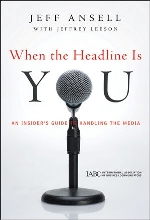|
by
Jeff Ansell
Jeff Ansell
& Associates
 Ask
most journalists how they see news and their response will likely be about
the pursuit of truth. To pursue truth is indeed a noble path. To get to
their truth, journalists, news producers, and editors cast characters and
build stories around them—stories that involve controversy, conflict,
and emotion. Ask
most journalists how they see news and their response will likely be about
the pursuit of truth. To pursue truth is indeed a noble path. To get to
their truth, journalists, news producers, and editors cast characters and
build stories around them—stories that involve controversy, conflict,
and emotion.
The problem,
of course, is in the ambiguity of interpreting truth itself. As revealed
in Brinkley’s quote about news being what he says it is, one person’s
terrorist is another person’s freedom fighter. But who gets to decide
which player is the terrorist and which is the freedom fighter?
Reporters, along with editors and producers, decide who plays the hero or
villain in a story. Like Steven Spielberg, they hand out roles for
tonight’s evening news and tomorrow morning’s newspaper. Starring
roles are reserved for the protagonist and the antagonist, the hero and
the villain. Supporting roles are available for the victim, witness,
survivor, expert, and goat, or as I like to call that character, the
village idiot. Usually, it is the village idiot who caused the problem in
the first place. On occasion, the village idiot also stars as the villain.
A front page headline in the July 28th, 2005 edition of Canada’s Globe
and Mail newspaper read, “A landlord, an eviction, and a dying man’s
last wish.” The story was about a twenty-nine year old terminal cancer
patient being evicted because he owed his landlord sixteen hundred
dollars. Asked whether she had sympathy for the sick tenant, the landlord
snapped, “What am I, his mother? Why do I have to support him?” At
first blush, the roles are clear. The terminal patient is cast as both the
good guy and the victim, while the landlord is cast as the villain. But
how do we know that was indeed the case? It’s possible that the patient
was a tenant from hell and that the landlord had carried him for as long
as she possibly could.
In truth, personal bias determines who gets cast in what roles.
Journalists are not comfortable discussing personal bias. The role of the
journalist, they believe, is simply to report the truth. Never having
given it much thought during my reporting days, I suppose that my personal
biases led me to become an investigative reporter. My biases were
triggered by resentment I felt as a youngster over how my father was
callously laid off by uncaring factory owners. Becoming a journalist
allowed me to meet, challenge, and hold accountable people I perceived
(rightly or wrongly) as high and mighty. To me, working class characters
were heroes, while politicians, employers, and landlords were among those
cast as the villain.
On occasion, the media creates heroes only to turn them into goats. In
seeking the GOP nomination in 2008, Senator John McCain’s campaign was
given up for dead, when suddenly it was resurrected and McCain became a
darling of the media. Then, as he was about to secure the Republican
nomination, a New York Times story by Elizabeth Bumiller suggested McCain
had an inappropriate relationship with a female lobbyist thirty years his
junior. There was no proof of impropriety offered in the story, only
nameless sources serving up gossip and innuendo. Though no fan of McCain,
conservative commentator Rush Limbaugh said, “If you let the media make
you, you are subjecting yourself to the media being able to destroy
you.” Is it any wonder people are gun shy of reporters?
Jeff
Ansell is the
author of When
the Headline is You, and a media and crisis communications
consultant helping Fortune 500 companies to manage high-profile issues,
including the Erin Brockovich case. He is founder and principal of the
consulting firm Jeff Ansell & Associates.
More
Articles | Submit
Your Article | PR
Subjects
About
Public Relations Homepage
Contact Us
|



